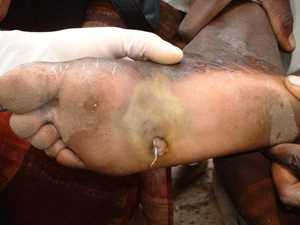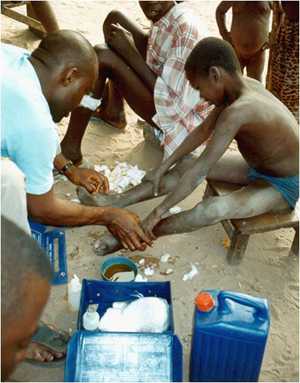Disease

Emergence of a Guinea worm from a foot. Photo credit: E. Wolfe, 2003,The Carter Center.
Symptoms
People with Guinea worm disease (GWD) have no symptoms for about 1 year. Then, the person begins to feel ill. Symptoms can include:
- Slight fever
- Itchy rash
- Nausea
- Vomiting
- Diarrhea
- Dizziness
A blister then develops. This blister can form anywhere on the skin. However, the blister forms on the lower body parts in 80%–90% of cases. This blister gets bigger over several days and causes a burning pain. When the person puts this affected body part in cool water to ease the symptoms, it is thought that the worm detects the temperature change and bursts from the blister to release hundreds of thousands of larvae into the water[1, 2].

Painful extraction of a Guinea worm. Photo credit: Louise Gubb, 2007.
Complications
In addition to the pain of the blister, removing the worm is also very painful. Furthermore, without proper care the wound often becomes infected by bacteria. These wound infections can then result in one or more of the following complications:
- Redness and swelling of the skin (cellulitis)
- Boils (abscesses)
- Generalized infection (sepsis)
- Joint infections (septic arthritis) that can cause the joints to lock and deform (contractures)
- Lock jaw (tetanus)
If the worm breaks during removal it can cause intense inflammation as the remaining part of the dead worm starts to degrade inside the body. This causes more pain, swelling, and cellulitis[1, 2].
Disability
While the death rate is low, disability is a common outcome of GWD. People have difficulty moving around because of pain and complications caused by secondary bacterial infections. The disability that occurs during worm removal and recovery prevents people from working in their fields, tending animals, going to school, and caring for their families. Disability lasts 8.5 weeks on average but sometimes can be permanent. When GWD was more common, the negative impacts on farming and livestock tending caused financial losses in the millions of dollars each year. In some villages where infection rates were high, more than 60% of children missed school. Some children were disabled by infection. Other children needed to work in place of disabled family members[1, 2, 3, 4].
GWD only occurs in the poorest 10% of world’s population who have no access to safe drinking water or health care. Therefore, GWD is both a disease of poverty and a cause of poverty[1, 2, 3, 4].
Reference
- Greenaway, C., Dracunculiasis (guinea worm disease). CMAJ, 2004. 170(4): p. 495-500.
- Ruiz-Tiben, E. and D.R. Hopkins, Dracunculiasis (Guinea worm disease) eradication. Adv Parasitol, 2006. 61: p. 275-309.
- Hopkins, D.R., et al., Dracunculiasis eradication: delayed, not denied. Am J Trop Med Hyg, 2000. 62(2): p. 163-8.
- Hopkins DR, Hopkins EM. Guinea Worm: The End in Sight. In: Medical and Health Annual, E. Bernstein ed. Encyclopedia Britannica Inc., Chicago 1991:10–27.
- Page last reviewed: November 21, 2012
- Page last updated: November 21, 2012
- Content source:


 ShareCompartir
ShareCompartir